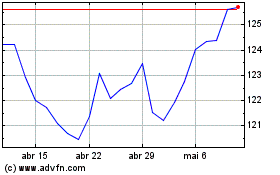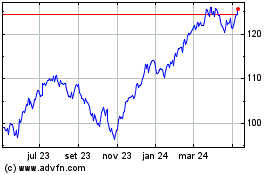Sector EER: Downward Trend Reverses - Cook`s Kitchen
04 Outubro 2012 - 9:00PM
Zacks
As we head into the thick of earnings season over the next few
weeks, it's a good time to look at what's going on with Earnings
Estimate Revisions (EER). And one way that I like to do that is by
sector.
Since Zacks collects all the earnings
estimates and revisions from the Street, every day, we get to
compile the data in some unique ways so we can get a good look at
big picture trends.
The last time I looked at our aggregate EER data
was in mid-July, when I thought we may be in a period of peaking
corporate profits. I wanted to see what individual sectors had to
say.
The table below displays what we call the EER Ratio
for the S&P 500, which is simply upward EER vs downward ones. I
have picked five broad sectors that represent some of the highest
investor interest and sensitivity to the economic cycle. And I
threw in Consumer Staples (XLP) for a base of comparison..
Obviously, an EER Ratio over 1.0 means more
estimates have gone up than down. Below 1.0 means more negative
revisions than positive. In July, I compared data to the year ago
period by taking the average of the first 3 weeks for each July. In
the middle column, I show the interim peak ratio and when it
occurred.
This week, I am adding the August average (4 weeks
of data) and the September numbers through October 2nd (5 weeks of
data) so that we can see the improvement out of a pessimistic
spring. And August is significant because it is one of the four
months of the year that will typically have the most revisions as
it comes after most companies in the S&P have reported for the
June quarter.

In July, downward EER dominated. At the time I
asked, "Is this a sign of peak earnings or will the S&P
continue to shoot for its first year over the elusive $100 EPS
mark?"
And I had to admit that I didn't know. But I
promised to keep an eye on the revision trends along with our
Director of Research, Sheraz Mian, and his excellent updates every
week. Here's his preview of Q3 from last week, Earnings
Expectations: Too High or Too Low. Be sure to look for a new
piece next week on the home page.
Also back in July, it was worth pointing out some
bright spots: Construction and Transportation sectors were sporting
very positive EER Ratios at 1.4 and 1.0 respectively. By the way,
Zacks breaks the market/economy into 16 sectors vs the traditional
9 Select Sectors of Standard & Poors (represented in the table
by their SPDR ETF symbols).
What's new is that Construction has continued its
strong trend, with an average EER for August and September of 1.25
and 1.49 respectively. This fits with the "animal spirits" we've
been seeing in the housing recovery.
Meanwhile, Transportation continues to drop at 0.86
and 0.26 for those months. This fits with the dismal performance
we've seen in the Dow Transports index and weaker outlooks from
FedEx and the rail companies.
One sector conspicuous by its absence is of course
the Financials. The sector has been the strongest this year, with
about a 24% return, versus about 22% each for Consumer
Discretionary and Technology. Finance has averaged an extremely
stable EER just over 1.0 for both August and September.
Observations and Conclusions
Estimates have been coming down, there is no doubt
about that. But not as fast as we expected in July. The aggregate
impact on bottom-up estimates for the S&P 500 has been less
than 1% as it slips from around $103 to $102.
Though downward revisions continue to dominate, the
"less bad" nature of them is somewhat encouraging in the face of
the worst Q3 in 3 years and the slew of negative pre-announcements
we've already had.
That's why I highlighted the rising EER trend from
July through September in green. It's still not positive, but it is
going in a good direction and stocks have responded accordingly in
the past three months.
The impact on 2013 aggregate S&P estimates has
also been tame (so far) with top-down estimates slipping from $110
to $108.50. But these estimates for next year are really dependent
on two big factors that haven't been fully, or accurately, weighed
yet: (1) more realistic (less optimistic) GDP models for 2013 and
(2) corporate guidance and outlooks for the first quarter and
beyond.
For clarity's sake, let me reiterate that the bulk
of EER will come next month. February, May, August, and November
are usually the height of earnings season and so are the center of
EER activity where you can see anywhere from 12,000 to 17,000
revisions. Yep, that's counting every single quarterly or yearly
adjustment by analysts.
The total market EER ratios for the last 3 weeks
have averaged about 4300. The next few weeks will be critical in
determining if US corporations can maintain their advances -- and
not just in cutting costs that stretch weaker top lines into record
bottom ones.
Kevin Cook is a Senior Stock Strategist with
Zacks.com
SPDR-SP 500 TR (SPY): ETF Research Reports
SPDR-EGY SELS (XLE): ETF Research Reports
SPDR-FINL SELS (XLF): ETF Research Reports
SPDR-INDU SELS (XLI): ETF Research Reports
SPDR-TECH SELS (XLK): ETF Research Reports
To read this article on Zacks.com click here.
Industrial Select Sector (AMEX:XLI)
Gráfico Histórico do Ativo
De Dez 2024 até Jan 2025

Industrial Select Sector (AMEX:XLI)
Gráfico Histórico do Ativo
De Jan 2024 até Jan 2025
